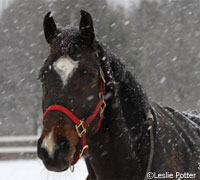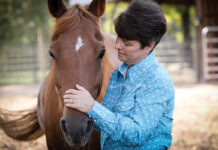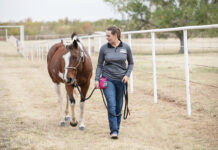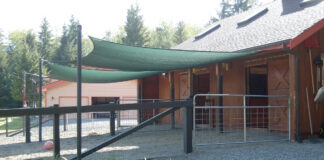 Peggy Gibson, 35, had lived in Florida most of her life. An owner of two Quarter Horses that she showed in pleasure classes, she relished her state’s moderate year-round temperatures (not to mention her ability to train consistently through the winter). Then Peggy got the word that her company was transferring her to Buffalo, New York, for two years to work on a major account. She’d not only have to move herself, but her horses, too — a big challenge. They’d rarely seen frost, and had never experienced snow.
Peggy Gibson, 35, had lived in Florida most of her life. An owner of two Quarter Horses that she showed in pleasure classes, she relished her state’s moderate year-round temperatures (not to mention her ability to train consistently through the winter). Then Peggy got the word that her company was transferring her to Buffalo, New York, for two years to work on a major account. She’d not only have to move herself, but her horses, too — a big challenge. They’d rarely seen frost, and had never experienced snow.
Seasonal Body Changes
As the days shorten in late summer to early fall, your horse’s body begins to react to the change of seasons. It begins to layer on fat under the skin and grow a long, dense coat to insulate him against the impending cold. When winter arrives and temperatures drop, changes in his circulatory system minimize heat loss through the skin. When needed, the muscle contractions of exercise create additional heat that gets trapped by the dense coat. Shivering (a last-ditch effort to keep warm) involves rapid muscle activity throughout the horse’s body and generates even more heat. Normally these physical adaptations are sufficient to protect a horse when he’s kept outdoors at pasture in all but the most extreme wet and windy weather.
However, a horse’s body is designed to add only as much fat and hair coat as needed, based on the weather conditions as the season changes. If these changes in climate are minimal and stay above freezing, as they usually do in coastal and southern regions, your horse’s physical response will be mild. But if he’s suddenly transported to an extremely cold climate, his body will be challenged beyond its preparation.
First, discuss the upcoming move with your horse’s current vet to develop a management strategy for the move. Also ask your vet to put you in contact with a colleague in your new town so you don’t have to search for one in the midst of an unexpected emergency. Another option is to call the state veterinarian (find him or her through the American Association of Equine Practitioners at 606-233-0147) for recommendations, or get a copy of the local yellow pages for your new city. (A phone book will also help you locate a farrier and a boarding stable if you won’t be keeping your horse on your own property.) Ideally you’ll know a couple months ahead of time that you’ll be moving during winter, so you can begin to prepare your horse as you search for his new home.
Welcome the Woollies
To prepare for the future cold, while he’s still in a moderate climate, don’t blanket him when the weather cools and he begins to get hairy; and don’t leave lights on to limit his hair coat. This is even more important if you plan to keep your outdoor horse in a pasture or outdoor pen. As long as he’s healthy, has shelter against wind and rain, and receives adequate nutrition, a few nights of enduring the mild chill now will better prepare him for the truly cold weather he’ll be living in later. Lights and blanketing will only blunt his body’s effort to adapt by interfering with the “message” the fall weather brings about the coming winter. Trying to minimize your stabled show horse’s coat for the winter circuit is counterproductive if you want him to adjust to the cold. Also, pastured horses will need that extra hair to insulate them from the wet ground when they lie down to sleep — so clipping should be kept to minimum.
Keep in mind that with a woolly coat, you’ll need to take extra care to cool him out and dry him after workouts. A wet coat loses its insulating abilities and your horse can become chilled in even mild weather.
Plump Him Up
Not only will he need his dense hair coat to withstand the bitter chill, he’ll need a sufficient layer of insulating fat. Adding a few extra pounds can help your horse stay warm while his body adjusts to the temperature difference. If he doesn’t receive enough calories to burn from an adequate diet, his body will revert to the fat stores in his body — including that important insulating layer. Once those become depleted, his body will turn toward muscle and other organs in its attempt to maintain a normal body temperature. Consult your vet for tips on gradually increasing caloric intake without risking colic or laminitis.
Cutting back on exercise may seem like a quick way to pack on some pounds, but keep in mind that a fit horse is healthier and better able to withstand challenges in the form of weather, illness and injury. You should be able to feel ribs, but not see them, feel fat on his tailhead without seeing a bulge, and his shoulders, back and withers should be rounded but not surrounded by thick, lumpy pads of fat. Finally, before moving day, make sure your horse is current on all vaccinations and deworming treatments so he won’t have to deal with an internal assault while trying to cope with the stress of moving. Whether you’re transporting him between states (and are required to have a health certificate), or you’re just moving to colder regions within the state, have your vet examine your horse for health problems.
Gimme Shelter
While you’re preparing your horse for the demands of his new climate, you should also be spending some time finding or preparing a suitable shelter. You may be told by locals that the horses do just fine left outside unprotected without blankets. While that may be true if you were to move your horse in summer or early fall to give him time to acclimate, they may not realize the effect the dramatic difference in environment can cause. You would be appalled if your horse had gone from plump to gaunt in a single night or two from nonstop shivering.
If you don’t have ample moving notice, choose a barn with well-ventilated — but not drafty — box stalls and blanket him appropriately for freezing weather. If stabled outside, the minimum he’ll need is a covered, three-sided shelter from wind and rain. It’s also a good idea to install a heated waterer. Adequate water intake is just as important in winter as it is in summer, but because it’s so cold, horses often don’t drink enough. If the water trough doesn’t have access to electricity, insulate it by dropping in a large inflated rubber ball to keep ice from forming. Invest in a hay rack or pallet if you’ll be feeding your horse in a pasture, to keep hay from getting churned into the snow and mud. Also consider stall mats and bedding for extra insulation at bedtime.
If you’ll be boarding, find out the type and amount of hay the barn offers. You may need to purchase additional hay and possibly supplements to give your horse enough nutrients and calories. If you’re looking for a pasture situation, find one that also has a barn where your horse can get shelter in case a severe storm is too much for him.
Arrival
When your horse steps off the trailer and into snow for the first time, be prepared to have your hands full. Although many horses take snow in stride and even seem to enjoy playing in it, others are frightened at first by this new stuff that looks solid but gives way beneath their hooves. If your horse becomes anxious, stay calm and speak soothingly. He may never learn to love it, but at least he may accept it.
For his first few days, keep your pasture horse separated from the rest of the herd. He shouldn’t have to establish pecking order or fight for his food ashe’s adjusting to the extreme cold. Traveling through snow and mud takes more work than on flat, dry ground and skirmishes can quickly fatigue muscles and cause tendon and ligament trouble — in addition to injury from bites and kicks your horse is unable to avoid because he’s yet not adept at moving on the slippery ground. A quarantine will also allow him time to acclimate before having to fight off infections from other horses. When you do acquaint him to the herd, first put him in a pen alongside the pasture for a few days so they can see, smell and hear each other, but can’t fight.
Resist the urge to ride through the white stuff on day one. For the first few days stick to hand walking to allow your horse a chance to adjust his balance and stride in the snow. This will give you a good idea of how hard the going is — and how tiring it can be! Go gradually to allow your horse the time he needs to build up speed and duration. Rushing can lead to serious injury.
Monitor your horse’s condition over the next several weeks. Because it requires so much energy to process, roughage is the best feed to help your horse produce warmth, however, if he drops too much weight, you’ll need to feed him fats to build up that insulation layer. Be wary of feeding him too much grain in your attempts to add calories, which can lead to laminitis. Work with your new vet to adjust your horse’s diet until he can maintain a healthy weight.
Generally speaking, most horses adapt to a new environment within a few weeks. With a little common sense and effort on your part, you can help him adjust without strain.
Further Reading
Prepare your horse for cold weather
Horse Blanket Central






Good tips!